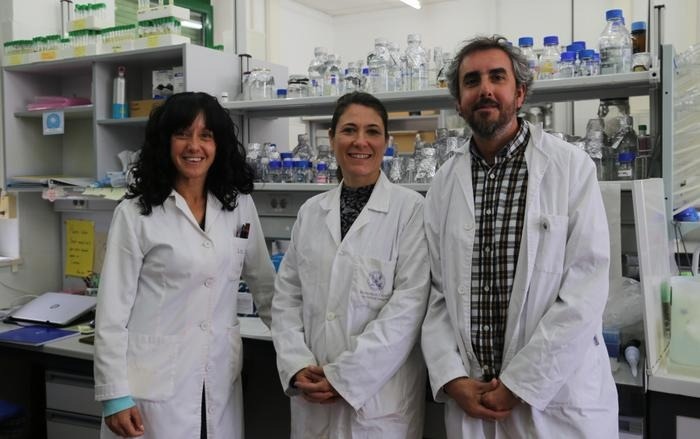A combination of bacteria and algae increases biomass and green hydrogen production while purifying water.
 Researchers who carried out the study. Image Credit: University of Córdoba
Researchers who carried out the study. Image Credit: University of Córdoba
A team from the University of Cordoba has found that the mutual relationship between three bacteria and algae shows the highest hydrogen production this kind of consortium has yet achieved.
Hydrogen is expected to be one of the fuels of the future; therefore, researchers are seeking ways to make it as sustainable and green as possible. The current methods of producing hydrogen, which involve using fossil fuels or the electrolysis of water using energy, can be avoided by employing consortia of bacteria and algae to produce hydrogen.
Within this strategy, governed by Circular Economy principles, the issue is: What is the most effective mix of algae and bacteria?
The University of Córdoba’s BIO128 research group has been searching for these mutualistic relationships between algae and bacteria that produce biomass and hydrogen while also cleaning the wastewater in which they coexist.
They have now uncovered a link between algae and three bacteria that, when combined, can make hydrogen and grow together, generating biomass that can be retrieved while also cleaning the wastewater in which they develop.
The Chlamydomonas reinhardtiialga model and the three bacteria Microbacterium forte sp. nov., Bacillus cereus, and Stenotrophomonas goyi sp. nov. make up this winning combination, and the amount of hydrogen produced is the highest of any combination that has been reported.
The Chlamydomonas alga produces hydrogen with the assistance of the M. forte bacteria. When the other two bacteria are added to the mixture, the bacteria and the algae grow and produce biomass, which can later be recovered and used as a fuel or energy source, while hydrogen is produced.
This consortium is better because it is more lasting; you can grow it and obtain hydrogen and biomass for a long time, unlike other consortia, and we also discovered that Microbacterium forte and Stenotrophomonas goyi need vitamins (biotin and thiamine) and reduced sources of sulfur to grow, and what Chlamydomonas surely does is provide them with those nutrients that bacteria need to grow.
David González, Study Researcher, University of Córdoba
As a result, the bacteria gain from their partnership with the algae by providing it with the CO2 and acetic acid it needs to develop and produce hydrogen.
It is a win-win situation for the environment and water. By cultivating wastewater, these consortiums use the waste to grow and carry out water bioremediation tasks. This particular consortium has been tested using artificial wastewater that mimics lactic residues, such as lactose.
Our approach also harnesses the potential of using waste materials as a source of nutrients, thereby facilitating renewable and sustainable biohydrogen production. With the advantage that this consortium has a hydrogen production approximately ten times greater than that of the previous ones.
Neda Fakhimi, Study Author, University of Córdoba
The Result of Accidental Contamination in the Laboratory
This consortium came about thanks to a fortuitous contamination of a Chlamydomonas culture in the laboratory, which led to the discovery and sequencing of the genome of two new bacteria: Microbacterium forte and Stenotrophomonas goyi, also an author of the work.
Alexandra Dubini, Study Researcher, University of Córdoba
David González continued, “We realized that the contaminated culture produced more hydrogen than those that were not, and from there we followed up and saw that there were three bacteria.”
Thus, this study yields the genomes of these two recently discovered bacteria in addition to furthering the search for sustainable and biological ways to produce green hydrogen.
Journal Reference:
Fakhimi, N., et al, (2024) Chlamydomonas reinhardtii and Microbacterium forte sp. nov., a mutualistic association that favors sustainable hydrogen production. Science of the Total Environment. doi:10.1016/j.scitotenv.2023.169559